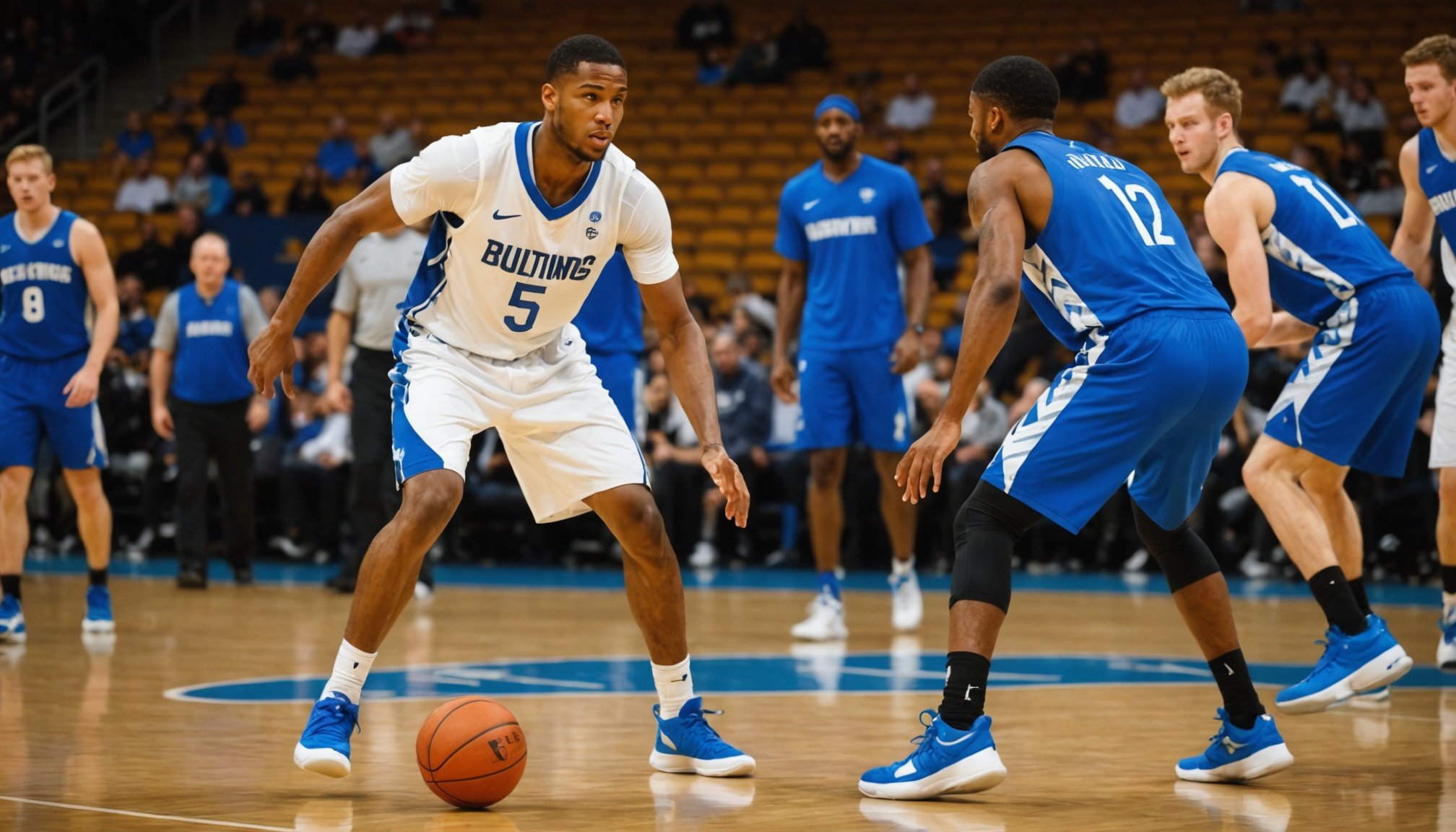Essential Warm-Up Routines to Safeguard UK Basketball Players from Hamstring Injuries
Understanding the Risk of Hamstring Injuries in Basketball
Hamstring injuries are a common plight for athletes, particularly those involved in high-intensity sports like basketball. The hamstrings, comprising the biceps femoris, semitendinosus, and semimembranosus muscles, are crucial for sprinting, jumping, and quick changes of direction – all essential movements in basketball.
“Hamstring injuries are one of the most frequent muscle injuries in sports, and they can significantly impact an athlete’s performance and career,” notes a study published in the British Journal of Sports Medicine.
Also to discover : Maximizing Game-Day Stamina: Essential Nutrition Strategies for UK Basketball Centers
The risk of hamstring injuries is heightened by several factors, including inadequate warm-up routines, sudden increases in training intensity, and poor muscle flexibility. Here’s how a well-structured warm-up can help mitigate this risk.
The Importance of a Proper Warm-Up
A proper warm-up is not just a preliminary step before training or a game; it is a critical component of injury prevention. Here are the key elements of an effective warm-up routine:
Also read : Top Agility Drills Every UK Basketball Forward Should Master
Active Warm-Up
The active warm-up phase involves total body movements at a low intensity, gradually increasing in effort and event specificity. This phase focuses on flexibility and proper mechanics.
“Start with controlled, easier exercises that focus on flexibility and proper mechanics,” advises the Outperform Sports guide on track and field warm-ups, which can be adapted for basketball players.
Dynamic Warm-Up
The dynamic warm-up phase increases the intensity with more dynamic movements that improve range of motion and stimulate the nervous system. This includes drills such as hamstring sweeps, alternating knee drops, and leg swings.
“Dynamic stretching, plyometrics, and strength exercises are particularly recommended to prevent hamstring injuries,” highlights an article on preventing hamstring injuries in UK basketball players.
Event Specific Warm-Up
Once the player is sufficiently warmed up, it’s time to incorporate event-specific exercises. For basketball, this might include drills that mimic the movements of the game, such as sprinting, jumping, and quick changes of direction.
“A complete warm-up should take 35-50 minutes and should include event-specific exercises to engage and activate the muscles, joints, and neuromuscular pathways most important to your event,” emphasizes the Outperform Sports guide.
Specific Warm-Up Exercises for Hamstring Prevention
Here are some specific warm-up exercises that can help prevent hamstring injuries in basketball players:
Hamstring Sweeps
- Why it works: Hamstring sweeps activate the hamstrings and get the nerves firing, reducing the risk of injury.
- How to do it:
- Stand with your arms at your sides and your palms facing forward.
- Place one foot ahead of you with your heel on the ground, your leg straight, and your foot flexed.
- Lean forward, reaching your hands towards your ankle in an upward sweeping motion.
- Stand up in a fluid motion and repeat with the other leg.
Alternating Knee Drops
- Why it works: Alternating knee drops warm up the hips and lower back, decreasing hip rotation tightness.
- How to do it:
- Sit with your knees bent in the same direction, resting on the ground while using your hands to support yourself behind you.
- Rotate your knees to bend in the opposite direction while keeping your feet touching the ground.
- Repeat switching sides for multiple reps.
Nordic Hamstring Exercise
- Why it works: This exercise strengthens the hamstrings, particularly in the lengthened position, which is crucial for preventing strains.
- How to do it:
- Start in a kneeling position with your hands under your shoulders and your feet under your hips.
- Slowly lower your torso forward, keeping your knees straight, until you can no longer control the movement.
- Catch yourself with your hands and return to the starting position.
Sample Warm-Up Routine for Basketball Players
Here is a sample warm-up routine that incorporates the above exercises:
| Phase | Exercise | Description | Duration |
|---|---|---|---|
| Active Warm-Up | Light Jogging | Jog around the court at a low intensity. | 5 minutes |
| Active Warm-Up | Leg Swings | Stand with your feet hip-width apart and swing one leg forward and backward, then switch to the other leg. | 3 minutes per leg |
| Dynamic Warm-Up | Hamstring Sweeps | Perform hamstring sweeps as described above. | 3 sets of 10 reps per leg |
| Dynamic Warm-Up | Alternating Knee Drops | Perform alternating knee drops as described above. | 3 sets of 10 reps per side |
| Dynamic Warm-Up | High Knees | Run with an exaggerated knee lift to warm up the hip flexors and hamstrings. | 3 minutes |
| Event Specific Warm-Up | Sprint Drills | Sprint short distances (20-30 meters) at high intensity. | 3 sets of 5 reps |
| Event Specific Warm-Up | Jumping Drills | Perform box jumps or depth jumps to activate the muscles used in jumping. | 3 sets of 5 reps |
Treating and Preventing Hamstring Injuries
While a proper warm-up is crucial, it is also important to know how to treat and prevent hamstring injuries.
Symptoms of a Hamstring Injury
- Pain in the back of the thigh and glutes when walking or bending over.
- Tender, bruised, or swollen muscles.
- Sudden pain or ‘popping’ during exercise.
- With a severe tear, you will not be able to walk or stand on the affected leg.
Treatment of a Hamstring Injury
- RICER Protocol:
- Rest your leg as much as possible.
- Ice therapy (apply ice packs for 20 minutes every two hours for the first 24 hours).
- Compress the injured leg using tape/bandage wrapped firmly around the thigh to minimize swelling.
- Elevate the leg using a pillow for support as much as possible.
- Refer to a medical professional if necessary.
Prevention Strategies
- Warming Up Thoroughly: Always start with a comprehensive warm-up routine.
- Cooling Down/Stretching: After physical activity, cool down with static stretches to reduce muscle tightness.
- Wearing Appropriate Footwear: Use supportive footwear to reduce the risk of injury.
- Gradual Increase in Intensity: Avoid sudden increases in training intensity.
- Active Recovery: Incorporate active recovery techniques such as stretching or foam rolling between training sessions.
Practical Insights and Actionable Advice
Here are some practical tips and actionable advice for basketball players to reduce the risk of hamstring injuries:
- Listen to Your Body: If you feel any pain or tightness in your hamstrings during the warm-up, stop and consult with a medical professional.
- Stay Flexible: Regularly incorporate flexibility exercises into your routine, especially after games or intense training sessions.
- Strengthen Your Hamstrings: Include strength exercises like the Nordic hamstring exercise in your training program.
- Use Proper Mechanics: Ensure that you are using proper mechanics during drills and games to avoid overloading your hamstrings.
Hamstring injuries are a significant risk for basketball players, but they can be mitigated with a well-structured warm-up routine. By incorporating dynamic movements, mobility exercises, and event-specific drills, players can reduce their risk of injury and perform at their best.
“Preventing injuries is not just about avoiding harm; it’s about optimizing performance and ensuring long-term health,” says a sports medicine expert.
By following the guidelines outlined above and making warm-up routines a priority, UK basketball players can safeguard themselves against hamstring injuries and achieve greater success in their sport.











